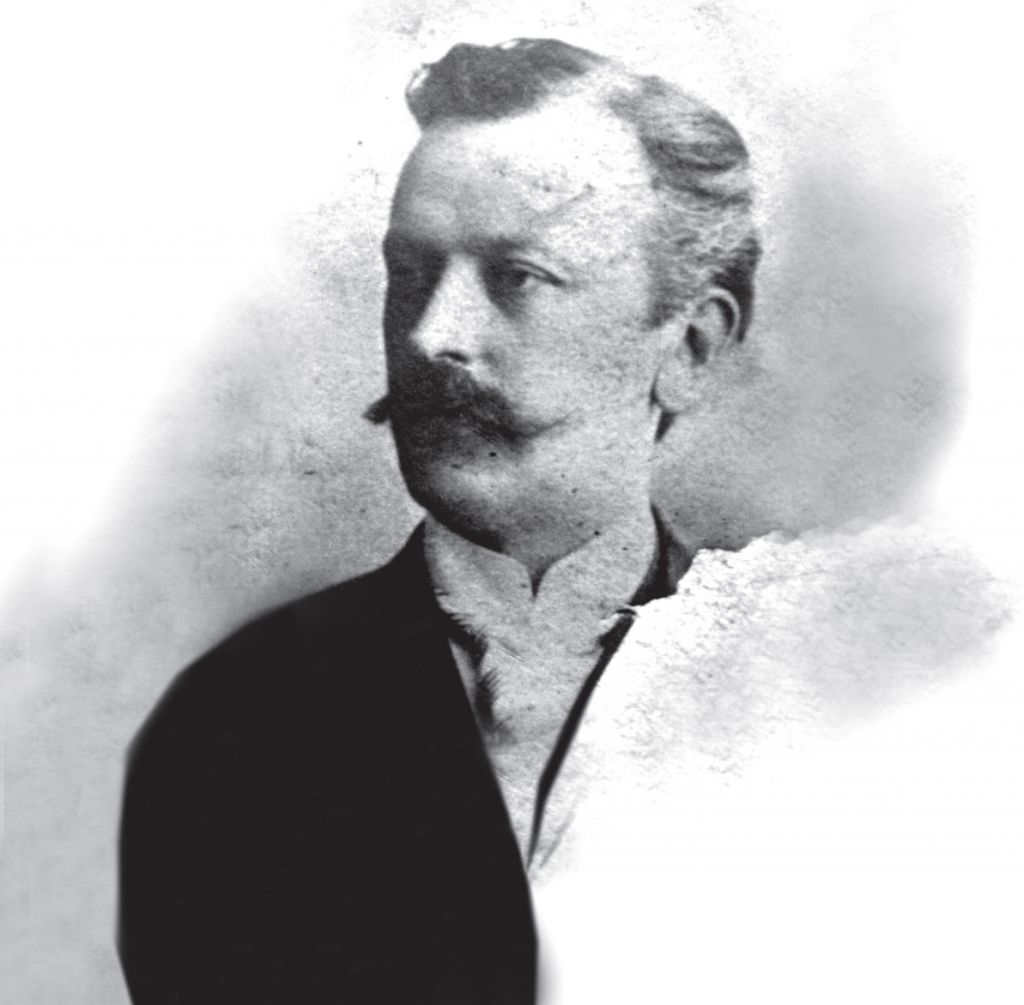Count Adam Skrzyński (1853–1905) – entrepreneur who brought Libusza into the global economy

“[…] known for exquisite elegance, a paragon of gentleman, desirable everywhere […]” (“Gazeta Narodowa” 1905, No. 170)
Oilman in the second generation
Count Adam Skrzyński came from an influential and centuries-old noble family from Greater Poland (Wielkopolska) which engaged in industry and trade in the nineteenth century – the “age of steam and oil”. He was the sixth child of Aleksander Skrzyński (1815-1874), the founder of the oil mine in Libusza in 1856, after whom he took over the oil business. In addition, he was a landowner in Libusza, Kobylanka, Kryg, and Zagórzany.
He was born in 1853 in Libusza, where oil was extracted from 1856, and where the pioneers in the distillation of rock oil began their daring work. He died in 1905 in Marienbad, and his body was deposited in the family mausoleum in Zagórzany.
Improvements in the Libusza mine
His uncle Tadeusz was involved in the extraction of oil, and Adam, thanks to foreign studies, was able to take over the duties of an oil entrepreneur after his death and manage the largest Galician mine at that time (the mine in Libusza covered about 470 hectares). In 1881, 74 workers worked in his mine, they drilled to a depth of 160 meters and produced 1200 cwt of crude oil (1 hundredweight is equal to 56.02 kg). The new owner took care of the mine’s constant development – he introduced a walking beam on a derrick (with a drill or chisel hanging on a hemp rope or chain) replacing the pickaxes in the hands of workers, and then in 1872 he used a horse treadmill, which significantly improved the extraction process.
Export pharmacy grade gasoline “Made in Libusza”
Due to the lack of market for crude oil, Skrzyński organised a refinery employing at first 30 employees in his hometown. The position of the chief distillation engineer was held by Michał Liwosz from Libusza, and the managing director was a chemical engineer Steinbor. The refinery enabled Skrzyński to process the raw material on his own and streamlined its sale. Thus he was able to produce pharmacy petrol, which he sold in England, Belgium, Germany, Sweden and France. He showed his products at industrial exhibitions organised in Galicia at that time, among others in 1882 at the Agricultural and Industrial Exhibition in Przemyśl, where the products from his refinery enjoyed great interest.
Development of the refinery in Libusza and specialists from Canada
In 1874, Count Skrzyński connected the refinery in Libusza with a railway line more than a kilometre long with the nearby main railway line in Zagórzany. In 1883, together with Aleksander Gorayski, he brought experienced Canadian miners to his mine (headed by William McGarvey), who were tasked with, among other things, implementing a new Canadian (pole-tool) drilling method.
MP and count
The owner of the mine in Libusza become also famous for being a politician. In 1882, at the age of only 29, he became the deputy of the Biecz-Gorlice constituency in the Diet of the Kingdom of Galicia and Lodomeria in Lviv, and in 1891, a member of the Viennese State Council from the district of Jasło-Gorlice. A few years later, in 1895, by the decree of the Emperor Franz Joseph I, he became a hereditary Austrian count. In the palace that he had received from his uncle in Zagórzany, where he lived with his wife Oktawia nee Tarnawska, he hosted many representatives of the world of industry and politics, including Count Badeni.
A Philanthropist, local patriot, community worker
Skrzyński generously supported young people from lower social classes with scholarships, as well as Gypsies – he offered them plots of land in the neighbouring Kobylanka, where they were able to settle. He also supported the local church and helped the local parish priest Kornel Radomski to build a primary school in Libusza – its construction was completed in 1893. During the years 1886-1892 he was also the chairman of the Agricultural Society in Gorlice. He cared not only for the development of his own business – he was also an active member of the National Petroleum Society, which cared for the joint affairs of all oil workers.
The Nobel brothers in Libusza – the flagship investment in the processing of crude oil
In 1918, the refinery in Libusza was purchased by Ludwig and Alfred Nobel – the sons of the famous inventor. The Nobels previously founded the Nobel Brothers Petroleum Company in Russia, through the agency of which they took control of over 51 percent of the extraction of this raw material in Russia. As a result of the Bolshevik Revolution of 1917, they lost their Russian assets, so they decided to move to Poland. After the purchase of the refinery , they began to invest in it, and increased its production capacity to 30,000 tons of crude oil per year. The huge scale of the investment, however, exhausted their cash resources and forced them to accept a new shareholder: Standard Oil Company belonging to John D. Rockefeller. In this way, a new company “Standard Nobel Spółka Akcyjna in Poland” was established. The refinery in Libusza was modernised once again, this time according to the American project: “it had 8 boilers with a capacity of one cistern (10,000 litres)”. The director of the refinery in Libusza was Letchford, an Englishman who had previously worked in the oil industry in Baku, where he had managed 26 refineries before the October Revolution. Employees laboured in a three-shift system in Libusza. Director Letchford did not allow working overtime. Most of the crude oil processed in Libusza came from the Boryslav Basin, while a smaller part from the mines in Libusza, Lipinki, Kryg, Kobylanka, Dominikowice and Biecz.
Apart from the refinery, the company also built housing estates with buildings for the board, managers and employees, as well as staff amenities: a casino, where meals were served and dances with a gramophone were held, and tennis courts where volleyball tournaments were played. There was also a reading room and a cinema in Libusza. The living and housing conditions in the company were therefore completely unheard of – a saying was coined to illustrate the state of affairs whereby “to have a job at the Standard Nobel SA Refinery in Libusza is a rare treat”. Every year boys from Libusza – primary school alumni – applied for a job at the refinery: they took “writing, calculation and intelligence” exams, after which they were able to start their career in the oil industry, at first as refinery messengers, and with time as mechanical workshop workers.
In 1937, during the economic crisis, the already unprofitable refinery was shut down. A fortnightly sit-in strike of several hundred refinery workers in the defence of the workplace ended in defeat. Dozens of them were relocated to Czechowice, the rest received payoffs appropriate to seniority. The equipment was moved to Czechowice or sold out.
Inspirations:
- Akcja spółki Standard Nobel w Polsce (A share of Standard Nobel company in Poland), in: University of Warsaw Library.
- Libusza przed likwidacją (Libusza before liquidation) (press article from 1937), in: From borderland – regional historical blog.
- Pabis Tadeusz, Adam hr. Skrzyński (1853–1905), Libusza–Tuchów 2010.
- Pabis Tadeusz, Śladami gorlickich naftowców (Trails of Gorlice Oilmen), Libusza–Tuchów 2006.
- Skorupski Jacek, Standard-Nobel w Polsce SA, in: Wirtualne Muzeum Papierów Wartościowych.
- Wójcik Adam, Fabryka głosi swoją śmierć – likwidacja rafinerii w Libuszy (The factory announces its demise – liquidation of the refinery in Libusza), (press article from 1937), in: Z pogranicza – regional historical blog
- Count Adam Tomasz Zaremba Skrzyński, in: zagorzany.com.pl, based on Złota księga szlachty polskiej by Teodor Żychliński (Poznań 1898)
Source of the photo: the Museum of Oil Industry and Ethnography in Libusza (the archive of Anna and Tadeusz Pabis)

